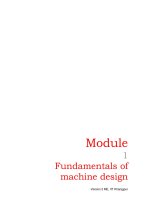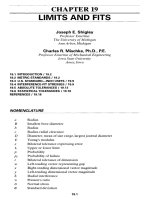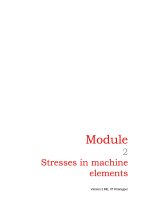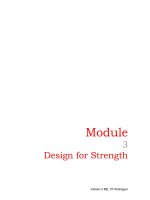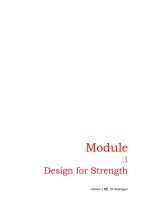Tài liệu Fundamentals of Machine Design P1 pdf
Bạn đang xem bản rút gọn của tài liệu. Xem và tải ngay bản đầy đủ của tài liệu tại đây (102.29 KB, 11 trang )
Module
1
Fundamentals of
machine design
Version 2 ME, IIT Kharagpur
Lesson
1
Design philosophy
Version 2 ME, IIT Kharagpur
Instructional Objectives
At the end of this lesson, the students should have the knowledge of
• Basic concept of design in general.
• Concept of machine design and their types.
• Factors to be considered in machine design.
1.1.1 Introduction
Design is essentially a decision-making process. If we have a problem, we need
to design a solution. In other words, to design is to formulate a plan to satisfy a
particular need and to create something with a physical reality. Consider for an
example, design of a chair. A number of factors need be considered first:
(a) The purpose for which the chair is to be designed such as whether it is to
be used as an easy chair, an office chair or to accompany a dining table.
(b) Whether the chair is to be designed for a grown up person or a child.
(c) Material for the chair, its strength and cost need to be determined.
(d) Finally, the aesthetics of the designed chair.
Almost everyone is involved in design, in one way or the other, in our daily lives
because problems are posed and they need to be solved.
1.1.2
Basic concept of machine design
Decision making comes in every stage of design. Consider two cars of different
makes. They may both be reasonable cars and serve the same purpose but the
designs are different. The designers consider different factors and come to
certain conclusions leading to an optimum design. Market survey gives an
indication of what people want. Existing norms play an important role. Once a
critical decision is made, the rest of the design features follow. For example,
Version 2 ME, IIT Kharagpur
once we decide the engine capacity, the shape and size, then the subsequent
course of the design would follow. A bad decision leads to a bad design and a
bad product.
Design may be for different products and with the present specialization and
knowledge bank, we have a long list of design disciplines e.g. ship design,
building design, process design, bridge design, clothing or fashion design and so
on.
Here we are concerned with machine design. We now define a machine as a
combination of resisting bodies with successfully constrained relative motions
which is used to transform other forms of energy into mechanical energy or
transmit and modify available energy to do some useful work. If it converts heat
into mechanical energy we then call it a heat engine. This is illustrated in figure-
1.1.2.1.
Q
1
Q
2
W pdv=
∫
ANIMATE
1.1.2.1A- Conversion of heat to mechanical energy in a piston cylinder
arrangement.
In many cases however, the machines receive mechanical energy and modify it
so that a specific task is carried out, for example a hoist, a bicycle or a hand-
winch.
This modification or transformation of energy requires a number of machine
elements, some small and some large. Machine design involves primarily
designing these elements so that they may transmit the forces safely and
perform their task successfully. Consider the following simple mechanisms:
(a) Hand winch (b) Small press operated by a power screw..
Version 2 ME, IIT Kharagpur
In each one of these mechanisms some useful work is being obtained with
certain combinations of a number of machine parts. Designing these
mechanisms would involve firstly designing these elements and then assembling
them in order.
CLIPPING
1.1.2.1V Introduction to machine design
1.1.3 Types of design
There may be several types of design such as
Adaptive design
This is based on existing design, for example, standard products or systems
adopted for a new application. Conveyor belts, control system of machines and
mechanisms or haulage systems are some of the examples where existing
design systems are adapted for a particular use.
Developmental design
Here we start with an existing design but finally a modified design is obtained. A
new model of a car is a typical example of a developmental design .
New design
This type of design is an entirely new one but based on existing scientific
principles. No scientific invention is involved but requires creative thinking to
solve a problem. Examples of this type of design may include designing a small
vehicle for transportation of men and material on board a ship or in a desert.
Some research activity may be necessary.
1.1.4 Types of design based on methods
Rational design
This is based on determining the stresses and strains of components and
thereby deciding their dimensions.
Version 2 ME, IIT Kharagpur



